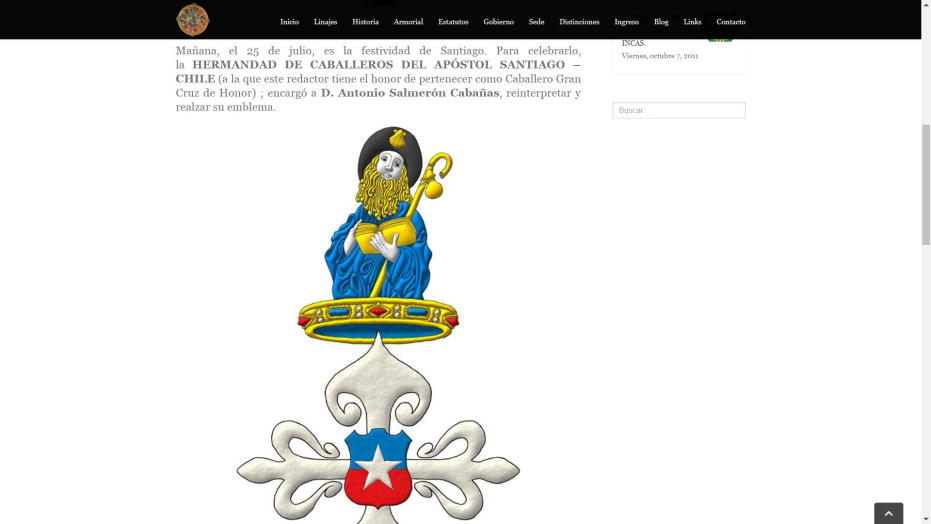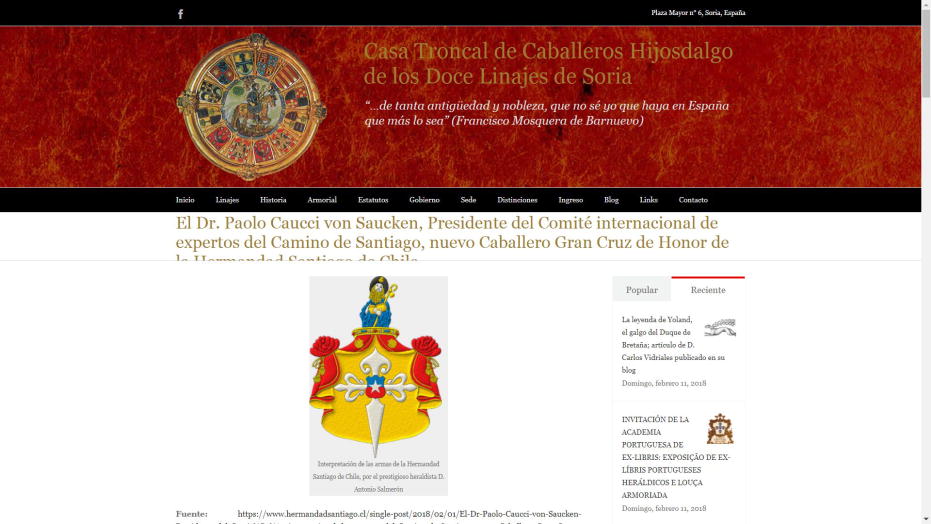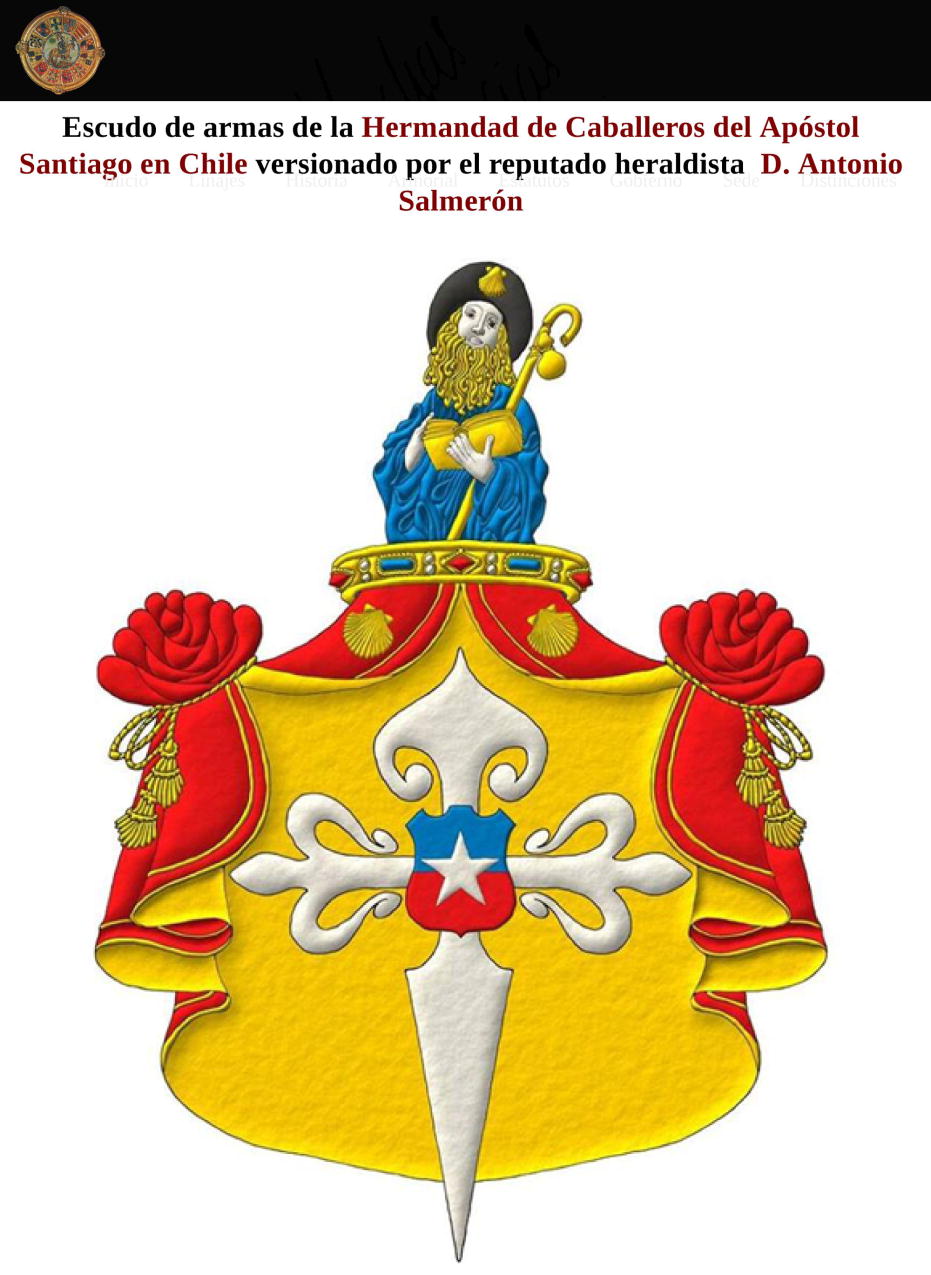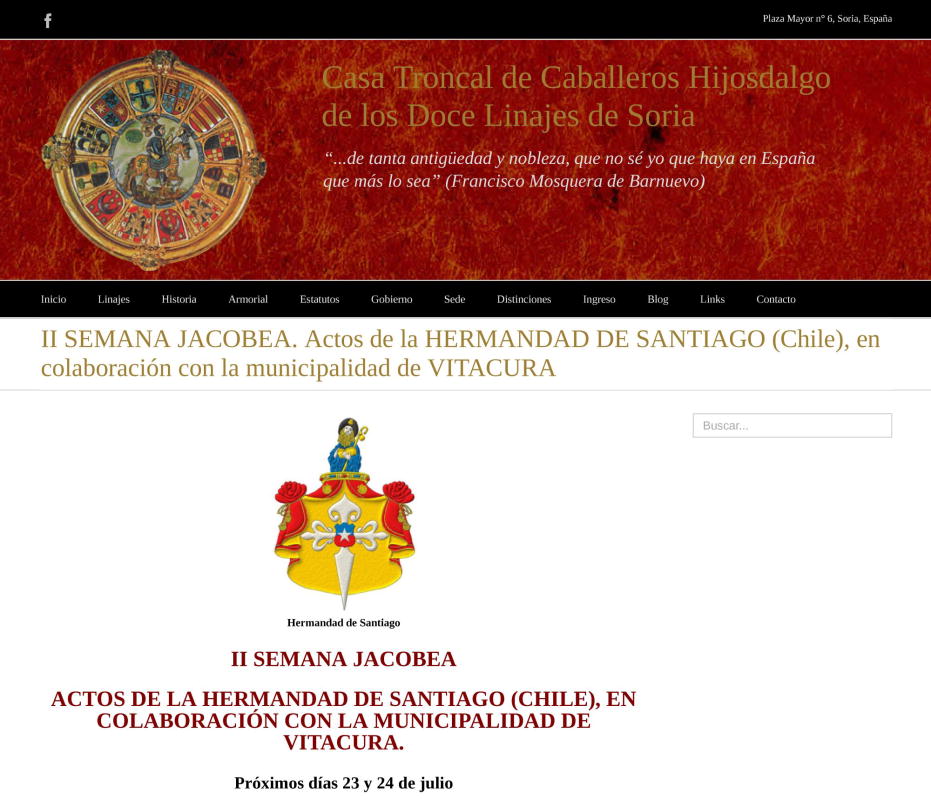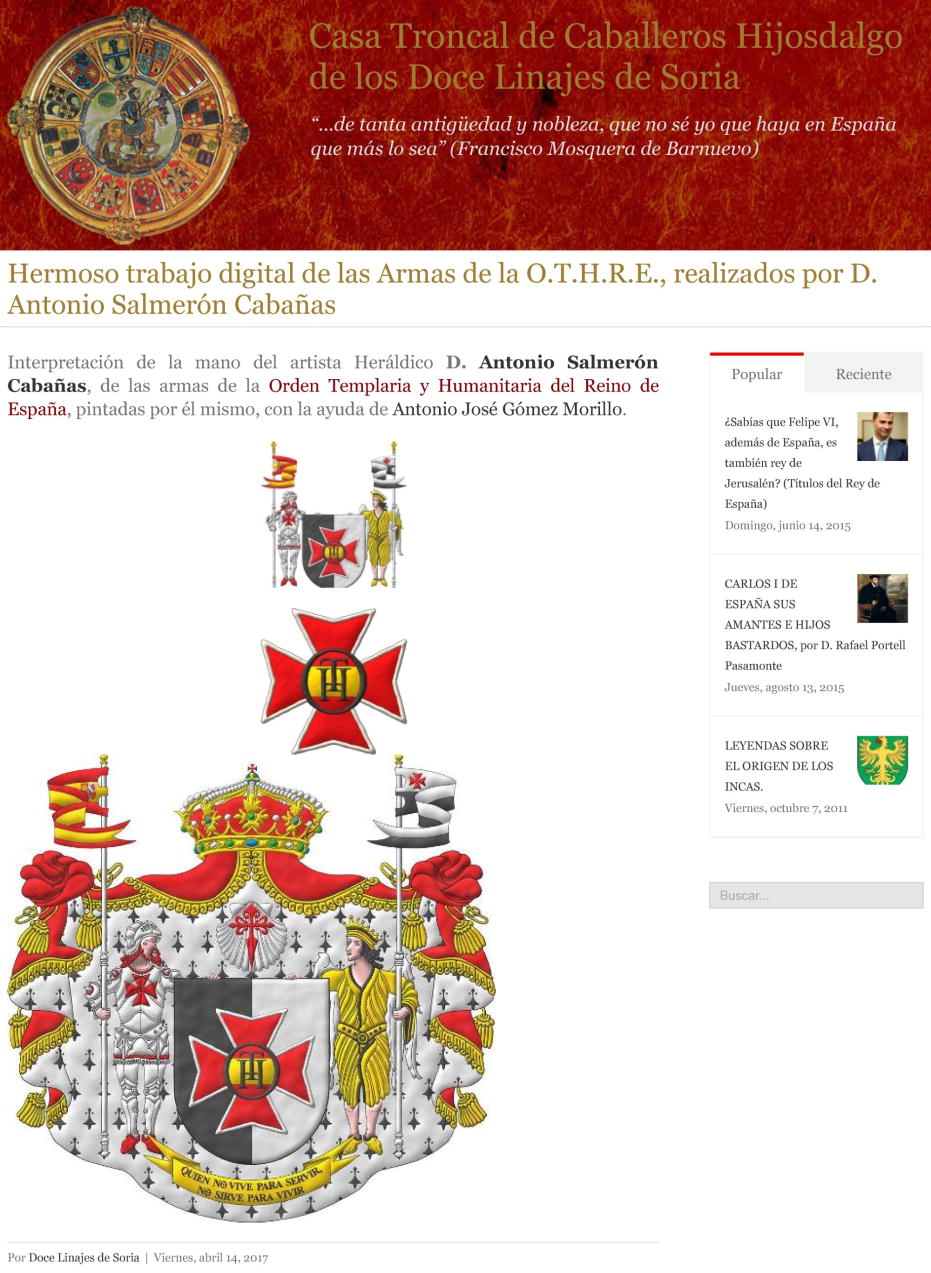Cross of Saint James


![Ver [Brotherhood of the Apostle Santiago, Chile in Twelve Lineages] en enlaces recomendados. Áncora de oro y la divisa enlace.](../css/Ancora.Enlace.png)
Brotherhood of the Apostle Santiago, Chile in Twelve Lineages
First publication of my heraldic artwork for this Brotherhood of the Apostle Santiago, Chile, on the blog Twelve Lineages of Soria under the following headline: Interpretation by the heraldic artist Mr. Antonio Salmerón Cabañas, of the arms of the Brotherhood of Knights of the Apostle Santiago (Chile).
Second publication of my heraldic artwork for this Brotherhood of the Apostle Santiago, Chile, on the blog Twelve Lineages of Soria with the following description of the illustration: Interpretation of the arms of the Santiago Brotherhood of Chile, by the prestigious heraldist Mr. Antonio Salmerón.
Third publication of my heraldic artwork for this Brotherhood of the Apostle Santiago, Chile, on the blog Twelve Lineages of Soria with the following description of the illustration: Coat of arms of the Brotherhood of Knights of the Apostle Santiago in Chile, versioned by the renowned heraldist Mr. Antonio Salmerón.
Fourth publication of my heraldic artwork for this Brotherhood of the Apostle Santiago, Chile, on the blog Twelve Lineages of Soria with the following description of the illustration: Brotherhood of Santiago.
Categories: Link, Republic of Chile, Freehand, Emblem, Crest and mantling, Sable, Argent, Or, Azure, Gules, Crown of Knight, Crown, Cross of Saint James, Cross couped, Party per fess, Overall (deprecated) and Mullet.
Root: Twelve Lineages of Soria.


Order of Santiago, emblem

Order of Chivalry of Santiago
A cross of Saint James.
Una cruz de Santiago.
Interpretation of the emblem of the order with: its cross outlined in Sable, illuminated in Gules; and a heavily hammered metal finish.
The Royal Council of the Orders of Chivalry of Santiago, Calatrava, Alcantara, and Montesa, in its historical account of the foundation of the Order of Santiago, describes three different points of view:
- The one presented by tradition, which establishes it in 844, after the battle of Clavijo, when fourteen knights led by the Field Master Don Sancho Martínez de Tejada requested permission from Don Ramiro I, king of Asturias between the years 842 and 850, to found it. This traditional view is the one recorded in [Avilés, J.; 1780b; treatise IV, chapter II, page 325] when discussing the origin of the «Military Order of Santiago of the Sword».
- The perspective of historians like Claudio Sánchez Albornoz or Américo Castro, who question the earlier date. Furthermore, [Sánchez Albornoz, C.; 1965; pages 94-136], as cited in [Domínguez García, J.; 2008; pages 69-70], proposes that the actual battle of Clavijo occurred later, in the year 859, and that Ramiro I did not participate, but rather it was a conflict between King Ordoño I and the Moor Muza.
- The view of historians who, based on the statutes of the order found in the Monastery of Uclés, which was the residence of the Master of the Order of Santiago, and the Latin in which they are written, believe that the foundation could indeed date back to the reign of Don Ramiro I.
Emblem
Regarding the emblem of the Order of Chivalry of Santiago, [Avilés, J.; 1780b; treatise IV, chapter II, page 328, plate 25, figure 100] states «the Commandery of this Order was always a red Sword» (gules ~ red), «in the form of a Cross, just as the guards of the ancient Swords that its Knights and Commanders carried on their white Mantles, and today also on the chest in the same manner, hanging from a red ribbon on a gold medal; that is, in a field of Or, a Cross of Gules».
Blazon keywords: Cross of Saint James, Cross couped and Cross.
Style keywords: Illuminated, Outlined in sable and Soft metal.
Classification: Interpreted, Religious, Military and Emblem.
Bearer: Santiago, Order of.


![Ver [Royal Council of the Orders of Chivalry] en instituciones citadas. Fortaleza de oro y mazonada de sable.](../css/Fortaleza.Institucion.png)
Royal Council of the Orders of Chivalry
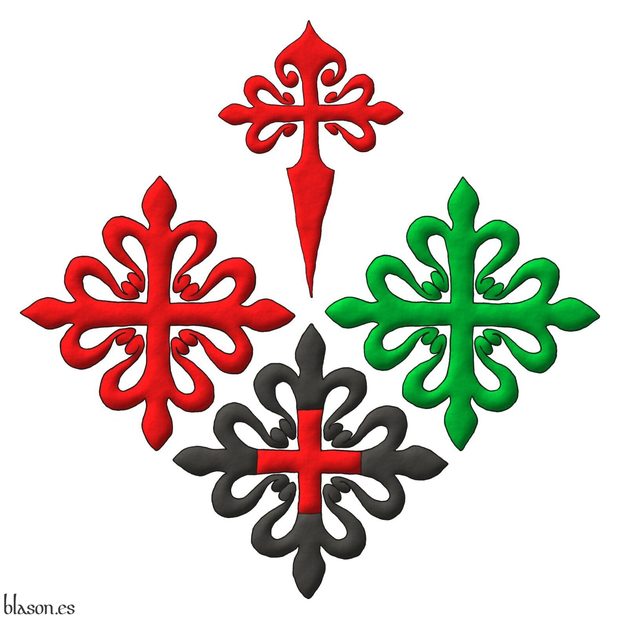
In 1523, the Order of Santiago, the Order of Calatrava, and the Order of Alcantara were definitively incorporated into the Crown of Castile, which marked the consolidation of the Royal Council of the Orders of Chivalry of Santiago, Calatrava, Alcantara, and Montesa. However, it is known that this Royal Council already existed at the beginning of the same 16th century, or even earlier, although there are no foundational documents available to date its inception.
The internet address of its website is ordenesmilitares.es where it also hosts the pages dedicated to each of its four orders:
- Order of Chivalry of Santiago: ordenesmilitares.es/orden-de-santiago.
- Order of Chivalry of Calatrava: ordenesmilitares.es/orden-de-calatrava.
- Order of Chivalry of Alcantara: ordenesmilitares.es/orden-de-alcantara.
- Order of Saint Mary of Montesa and Saint George of Alfama: ordenesmilitares.es/orden-de-montesa.
After the Crusades ended and following the model of the military orders created in the Holy Land, European kings established Orders of Chivalry, many of which were military and religious institutions, like the four grouped under this Royal Council.
Categories: Institution, Interpreted, Socioeconomic, Illuminated, Outlined in sable, Freehand, Emblem, Cross, Quarterly per saltire, Cross of Saint James, Cross couped, Cross of Calatrava, Cross of Alcantara and Cross of Montesa.


Royal Council of the Orders of Chivalry, emblem
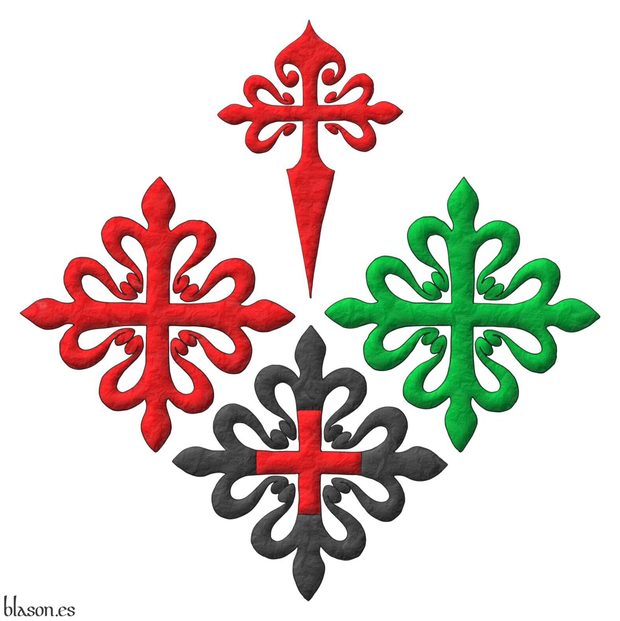
Royal Council of the Orders of Chivalry, of Santiago, Calatrava, Alcantara, and Montesa.
Emblem quarterly per saltire: 1, a cross of Saint James; 2, a cross of Calatrava; 3, a cross of Alcantara; 4, a cross of Montesa.
Emblema cuartelado en sotuer: 1o, una cruz de Santiago; 2o, una cruz de Calatrava; 3o, una cruz de Alcántara; 4o, una cruz de Montesa.
Interpretation of the emblem of the Royal Council with: its four crosses outlined in Sable, illuminated in Gules, Vert, and Sable; and a heavily hammered metal finish.
There is another version of this emblem of the Royal Council with the crosses of its four orders of Santiago, Calatrava, Alcantara, and Montesa outlined in Or instead of Sable.
Blazon keywords: Cross, Quarterly per saltire, Cross of Saint James, Cross couped, Cross of Calatrava, Cross of Alcantara and Cross of Montesa.
Style keywords: Illuminated, Outlined in sable and Freehand.
Classification: Interpreted, Socioeconomic and Emblem.
Bearer: Royal Council of the Orders of Chivalry.


![Ver [Santiago, Order of] en instituciones citadas. Fortaleza de oro y mazonada de sable.](../css/Fortaleza.Institucion.png)
Santiago, Order of
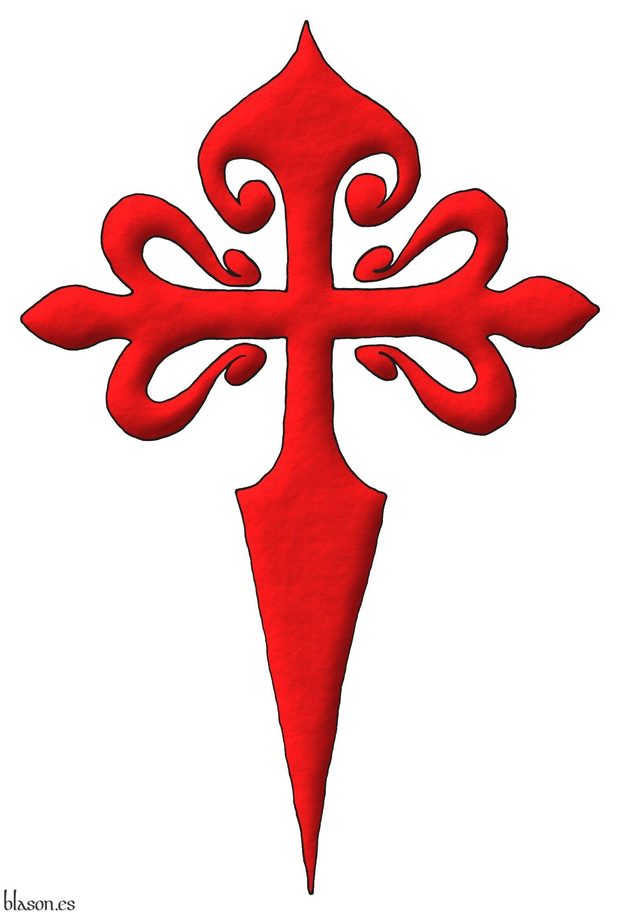
The Order of Chivalry of Santiago is both military and religious. It was founded in the Kingdom of León during the 12th century, although there is a difference of opinion regarding its exact year of foundation. It is named after the patron saint of Spain, James the Greater.
The purpose of its foundation was the protection of the Way of Saint James and the pilgrims who traveled it, and to participate militarily in the advancement of the reconquest of the Iberian Peninsula.
Of the Military Order of Santiago of the Sword, of its origin, and antiquity, as well as the form of its Commandery
[Avilés, J.; 1780b; treatise IV, chapter II, page 325] writes «The oldest authentic instrument that is found regarding the origin of the Order of Chivalry of Santiago of the Sword», observe how José de Avilés e Iturbide refers to the order in the masculine form, «is the donation made in the years of 848», note how the Marquess of Avilés does not doubt the antiquity of this order and even in other subsequent paragraphs, he dates it even earlier than currently believed, «made to the Church of Santiago by the King of León Don Ramiro in memory of the famous victory he achieved against the Moors in the battle of Clavijo (two leagues from Logroño), as evidenced by its Privilege, for having seen this Holy Apostle armed and mounted on a Horse, fighting in defense of the Christians; to whose devotion, and in this recognition, the said Order was instituted, taking from it its origin and name, as well as the same Cross that the Saint bore on his chest, and Shield, represented in the form of a Sword, of red color», gules ~ red, «for the blood shed of the Infidels, of whom Don Rodrigo Ximenez, Archbishop of Toledo, in his Chronicle Book VII says»: «Kubet ensis sanguine Arabum».
Drawing with a single stroke
Cross of Saint James the Greater drawing by me with a single stroke. This is the reason why it is asymmetrical, it has the base tip crooked, there are some sides higher than others, and it shows the failure of my pulse in a certains turns.
It is by far my most downloaded and copied painting, the most used on websites, citing me or not, the most used in hotels advertising, parish sheets... and even on T-shirts.
Categories: Institution, Interpreted, Religious, Military, Illuminated, Outlined in sable, Freehand, Emblem, Cross of Saint James, Cross couped and Cross.


![Ver [Templar and Humanitarian Order of the Kingdom of Spain in Twelve Lineages] en enlaces recomendados. Áncora de oro y la divisa enlace.](../css/Ancora.Enlace.png)
Templar and Humanitarian Order of the Kingdom of Spain in Twelve Lineages
My interpretation of the arms of the Templar and Humanitarian Order of the Kingdom of Spain with the help of Antonio José Gómez Morillo, on the blog Twelve Lineages of Soria in an article entitled: Beautiful rendering of the Arms of the T.H.O.K.S., created by Mr. Antonio Salmerón Cabañas.
Categories: Link, Watercolor, Freehand, Semi-circular, Closed royal crown, Crown, Supporter (human form), Supporter, Mantle, Sable, Gules, Argent, Or, Ermine, Cross of Saint James, Cross couped, Escallop, Flag and Party per pale.
Root: Twelve Lineages of Soria.
-
Language
-
Categories of heraldry
-
Divisions of the field
- Without divisions
- Party per pale
- Party per fess
- Party per bend
- Party per bend sinister
- Tierce
- Tierce sinister
- Tierced per pale
- Tierced per fess
- Tierced per bend
- Tierced pallwise inverted
- Quarterly
- Quarterly per saltire
- Gyronny
- Party per fess, the chief per pale
- Party per pale, the sinister per fess
- Party per fess, the base per pale
- Party per pale, the dexter per fess
- Chapé
- Chaussé
- Embrassé
- Contre-embrassé
- Party per chevron
- Enté
- Enté en point
- Flanched
-
Metals
-
Colours
-
Furs
-
Other tinctures
-
Ordinaries and sub-ordinaries
-
Diminutives of the ordinaries
-
Other charges
-
Charges from Nature
Water, Eagle, Bald eagle, Eagle claw, Dorsal fin, Tail fin, Two hands clasped, Lark, Tree, Trunk, Rainbow, Atom, Barbel, Acorn, Bighorn sheep, Arm, Owl, Vulture, Horse, Head, Goat, Camellia, Thistle, Merino ram, Kapok tree, Stag, Doe, Crescent, Increscent, Chrysanthemum, Tail, Tail addorsed, Ermine spot, Hummingbird, Snowflake, Heart, Roe deer, Neck, Stags' attires, Roe deers' attires, Raven, Dolphin, Diamond, Tooth, Elephant, Beetle, Emerald, Starling, Mullet, Mullet of four points, Star of David, Estoile, Male figure, Fleur de lis, Flower, Cornflower, Dogwood flower, Lotus flower, Hop cone, Bluebonnet, Puffin, Ash, Rooster, Claw, Talon, Goose, Heron, Seagull, Pomegranate, Sunflower, Swallow-tail, Falcon, Leaf, Boar, Goldfinch, Laurel, Barn owl, Lion, Lioness, Lion passant, Leopard, Lion rampant guardant, Lynx, Lily, Madonna lily, Flame, Wolf, She-wolf, Parrot, Moon, Hand, Apple, Apple tree, Sea, Martlet, Wing, Two wings in vol, Covert, Blackbird, Mount, Trimount, Fly, Wrist, Elm, Olive tree, Orbital, Bear, Palm frond, Palm tree, Dove, Poplar leaf, Panther, Jaguar, Vine, Paw, Forepaw, Foot (palmiped), Foreleg, Peacock, Chest, Pelican, Pelican in her piety, Dog, Brach hound, Warren hound, Fish, Hoof, Beak, Quill, Cinquefoil, Quetzal, Branch, Sprig, Frog, Shamrock, Caboshed, Oak, Holm oak, Rose, Double rose, Savage, Serpent, Plough of Ursa Major, Sun, Sun in splendour, Ray of the sun, Lightning flash, River, Stem, Badger, Tyger, Linden, Wheat, Wheat spike, Bull, Tulip, Udder, Escallop and Fox.
-
Artificial charges
Halberd, Plough share, Ace of spades, Anchor, Cyclamor, Torch, Bow, Arch, Harp, Non-classic artifact, Winnowing fan, Crozier, Conductor's baton, Pair of scales, Ship, Oar, Sail, Norman ship, Beret, Grenade, Ecclesiastical cap, Arm vambraced, Knight, Chain, Cup, Covered cup, Monstrance, Bell, Bell tower, Cannon dismounted, Carbuncle, Castle, Ribbon, Clarion, Nail, Crucible, Cord, Dagger, Key ward, Turret, With a turret, Armillary sphere, Sword, Federschwert, Sabre, Parchment, Scroll, Arrow, Club, Garb, Sheaf of tobacco, Scythe, Gauntlet, Axe, Buckle, Galician granary, Host, Bonfire, Polish winged hussar, Church, Fanon, Oil lamp, Spear, Spear's head, Fleam, Letter, Book, Open book, Closed book, Bookmark, Page, Line, Lantern, Key, Four crescents joined millsailwise, Hammer, Two-handed sword, Menorah, Mortar, Pestle, Number, Knot, Celtic Trinity knot, Water-bouget, Comb, Piano, Millstone, Millrind, Millwheel, Clay pot, Potent, Bridge, Cuffed, Hourglass, Chess rooks, Compass rose, Rosette of acanthus leaves, Mullet of six points pierced, Broken, Portcullis, Wheel, Wagon-wheel, Symbol, Sackbut, Drum, Geometric solid, Tetrahedron, Tower, Trident, Trumpet, Double vajra and Anvil.
-
Immaterial charges
Angel, Archangel, Basilisk, Heart enflamed, Sacred Heart of Jesus, Paschal lamb, Dragon's head, Dragon, Wyvern, Phoenix, Garuda, Griffin, Sea-griffin, Winged hand, Our Lady of Mercy, Pegasus, Saint George, Mermaid, Trinity, Triton, Golden fleece, Unicorn and Ouroboros.
-
External elements
-
Heraldic creations
-
References
-
Formats
-
Keywords on this page
Watercolor, Ermine, Azure, Flag, Crown, Crown of Knight, Closed royal crown, Party per fess, Cross, Cross of Alcantara, Cross of Calatrava, Cross of Montesa, Cross of Saint James, Cross couped, Quarterly per saltire, Outlined in sable, Emblem, Link, Mullet, Gules, Illuminated, Institution, Interpreted, Mantle, Semi-circular, Soft metal, Military, Or, Party per pale, Argent, Religious, Republic of Chile, Royal Council of the Orders of Chivalry, Sable, Santiago, Order of, Overall (deprecated), Socioeconomic, Supporter, Supporter (human form), Crest and mantling, Freehand, Twelve Lineages of Soria and Escallop.
